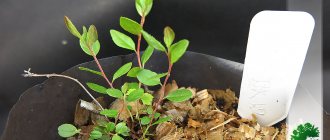Author:
Natalia
Category: Garden plants Published: February 09, 2019Added: January 23, 2020
Many calla lily lovers do not even suspect that its characteristic elegant snow-white or brightly colored “bags” are not flowers at all, but... special leaf-spreads that wrap the yellow ears of the inflorescences. Calla blooms inconspicuously, but very fragrant! We will reveal more secrets of the exotic beauty in our article.
- What to do if calla lilies do not sprout for a long time after planting?
- Why does calla lily begin to “cry”?
- Is it worth planting callas near large bushes and trees?
- Why can calla lilies lose color?
- How to get calla lilies to bloom earlier in the garden?
Let's figure it out together.
Planting and caring for callas
- Planting: tubers are planted in early May.
- Flowering: from June to early October.
- Excavation: in September.
- Storage: in an earthen coma in a dry room at a temperature of 5-7 ˚C.
- Lighting: bright light in the morning, light partial shade in the afternoon.
- Soil: well-drained, fertile, pH slightly acidic to acidic.
- Watering: moderate but regular, abundant in dry seasons.
- Fertilizers: Fertilizers are applied to the soil only during planting.
- Reproduction: vegetative, depending on the type - by tubers or dividing the bush. Seed propagation is ineffective and unreliable.
- Pests: aphids, thrips, mole crickets, beetles and wireworms.
- Diseases: rhizoctonia, root rot, penicillosis, pythium, Erwinia group of bacteria.
- Properties: the plant contains poisonous alkaloids. The juice, if it comes into contact with the skin, causes irritation, and if it enters the body, it causes vomiting, numbness and convulsions.
Temperature
This is a plant with a pronounced dormant period, which lasts 2 months a year and begins after the end of flowering. From the beginning of the growing season, a stable temperature with small average daily differences is needed.
It is best to keep the flower in a room at a temperature of 18-22ºС . This plant does not like heat; at temperatures above 27ºС, its leaves begin to dry out, despite the air being humidified. Cold is also detrimental to it, although Ethiopian calla can tolerate a short-term drop in temperature of up to 5ºC.
During the dormant period, the temperature of the plant should be within 10-15ºC.
Calla flowers - features
Growing callas, like any other plant, requires following the rules of agricultural technology, but the main feature of these flowers is that they are grown both as garden callas - in courtyards, and in apartments, in pots, like indoor callas. But there are still general rules for growing and caring for callas, no matter where they grow:
- callas require shallow planting, that is, the rhizomes are barely covered with soil to avoid rotting;
- What laymen call a calla flower is actually the covering leaf or spathe that wraps the spadix of the inflorescence. In fact, calla flowers are small and inconspicuous, although very fragrant;
- after planting, calla lilies do not sprout until they have formed their root system, so do not be nervous if there are no sprouts for a month;
- When digging up tubers, be careful: they are easily damaged;
- calla is a living barometer: droplets of water appear on its cover and the tips of its leaves before the rain, like tears;
- A pot for calla lilies, especially Ethiopian, is preferably porous so that excess moisture can evaporate. In addition, Ethiopian calla loves privacy and does not tolerate neighbors in its own pot;
- each calla flower blooms for about a month;
- From time to time, the top layer in the calla pot should be carefully removed, trying not to damage the roots, and replaced with fresh nutrient substrate.
Growing garden calla lilies
Callas decorate the garden so much with their majestic flowers that many gardeners are happy to grow them on their farms. The clearings where calla lilies grow look like an Arabic ornamental painting: the rhizomes annually produce young leaves, and elegant arrow-peduncles rise among them...
In the photo: Purple callas
Callas prefer open, spacious areas and fertile soils, but it is advisable to shade them during the hottest hours of the day: in the scorching sun, the leaves wither, burn and dry out, so it is important that bushes or trees grow nearby, which will provide the callas with saving shade in the afternoon. The soil must be acidic or at least slightly acidic; good drainage is required, because stagnation of water in the roots is detrimental to the plant.
The optimal composition of soil for calla lilies is: earth, sand, peat and leaf humus in equal proportions.
Reproduction
There are 2 options for propagating this plant.
- You can use seeds, as well as dividing tubers. The first option is quite complicated, we talked about it earlier. In this case, the planting material is soaked for several hours in sodium humate, after which it is placed in a damp towel and put away in a warm place with a constant microclimate for a week. When the seeds germinate, they can be planted in the soil.
- Reproduction by dividing tubers is simpler. The rhizome bulb grows annually. If, when replanting, you divide it into several pieces and plant it in different containers, the plant will feel great. However, it must be taken into account that for germination to occur, at least a single bud must be present on the selected bulb.
To learn how to properly grow calla lilies, watch the following video.
Planting callas and caring for the garden
Planting callas in spring
Garden callas are planted in early May. Pre-planting material is kept for half an hour in a solution of potassium permanganate, then carefully examined and, if necessary, rotten areas are cut out to healthy tissue, and the wounds are lubricated with brilliant green. Complex mineral fertilizer is added to the soil at the site at the rate of 30-40 g per 1 m², and the site is dug up. Then the tubers are immersed in prepared holes to a depth of 5-10 cm at a distance of 30-40 cm from each other (depending on the size of the bulb), buried, and the planting site is well watered.
How to grow cannas in the garden - with showy flowers and leaves
Calla lilies, if you remember, have a peculiarity: they do not sprout until they form an underground part, so if you are lucky, you will see sprouts in about two weeks, and if you are not very lucky, then in a month. Don't despair and don't try to dig a hole and see what stage the process is at. Do not water the calla lilies for the first two weeks: watering after planting is sufficient.
In the photo: Preparing calla bulbs for planting
There is a way to prepare calla lilies for planting in open ground: at the end of March or beginning of April, plant calla lilies in small pots to a depth of 2-3 cm in special soil for seedlings or in soil calcined for forty minutes in the oven. Water 1-2 times a week, and a week before transplanting into the ground, begin to briefly open the window to harden the plant. Calla lilies are transplanted into open ground together with a lump of earth.
Planting callas in autumn
Calla lilies are not planted in the fall.
Caring for calla lilies
How to care for calla lilies? It turns out to be very simple. Watering the calla lily followed by loosening is all that is needed for its normal growth. Plants should be watered moderately but regularly, increasing the amount of water during watering in hot, dry summers.
After each watering, lightly loosen the soil around the plants.
If you added complex fertilizers to the soil during planting, then you will not need further fertilizing of the callas, sometimes only, if the soil in the area with callas is not acidic enough, water it with water acidified with citric acid or vinegar.
Calla at home
Forcing home calla lilies
Homemade calla lilies are grown at a temperature of 22-25 ºC in the summer, and in winter – at a temperature not lower than 14 ºC. The place for the plant should be well lit, but shaded from direct afternoon sunlight and protected from drafts. The soil for home calla lilies should have an acidity of approximately ph 6-6; it would be a good idea to add sphagnum moss or peat with sawdust to the nutrient soil. The tuber for forcing calla lilies should be about 6 cm in diameter, it is planted with the convex side down in a container with a diameter of at least 25 cm, the planting depth is 5 cm. After planting the tuber, the soil must be spilled with a fungicide solution.
Sowing
How to plant calla lily seeds at home:
- To germinate seeds: soak for 5-7 hours in water, possibly with the addition of a growth stimulant (potassium humate), put in a shallow container, cover with gauze and put in a warm place for a week (20-23°C). Moisten the gauze periodically to prevent it from drying out. For germination, take moistened cotton swabs, placing seeds between them.
- Make holes (3 cm) in the soil and water.
- Place the sprouted seeds and sprinkle with soil. It is advisable to plant 3-5 seeds in one pot to ensure the appearance of sprouts.
Another option is how to plant calla lilies with seeds from China or a store: the seeds are not placed in holes, but laid out on the surface, lightly pressed, moistened and covered with polyethylene. The container is transferred to a bright place, protected from the sun, with an air temperature no higher than 20°C.
Callas after flowering
There are differences in caring for tuberous callas and rhizomatous callas. For Ethiopian calla, rhizomatous, the dormant period begins in the very heat - at this time growth slows down, then stops, the calla turns yellow... At this time, watering should be reduced, and the plant should be taken to the balcony or garden in a well-lit place where drops will not reach it rain. In the first half of July, the plant is taken out of the pot, all old leaves and shoots are removed and transplanted into a pot with a new nutrient mixture, placed in a bright place and they begin to water and feed the calla, preparing it for the next flowering. This is the cycle of rhizomatous potted calla lilies.
Garden calla lilies remain on the site until autumn; in September, the rhizomes are dug up and stored with a ball of earth in a cool, dry room with moderate, infrequent watering.
In the photo: Calla in a pot
After flowering, tuberous calla lilies gradually turn green and droop, the leaves turn yellow and dry. Garden tuberous callas are carefully dug up in the third decade of September, trying not to damage the tubers, freed from the soil, washed and kept for a couple of weeks at a temperature of 5-10 ºC, waiting for the beneficial nutrients to pass from the leaves to the tubers. After this, dead leaves are easily removed.
Soil composition
The soil for any plant is the direct basis for successful development, growth and flowering, so it is this point that should be given special attention. Calla lilies in the wild can most often be found on the banks of water bodies, so fairly moist and silty soil is an excellent option for this plant. On the site, in addition to shade, you need to worry about acidity, since it is the acidic soil that is the “stepfather” home for callas. To create favorable growing conditions, it is necessary to prepare a special mixture, which consists of equal parts of peat, leaf soil and sand, as well as a double part of turf soil.
Storing callas in winter
In our latitudes, callas are not left in the ground for the winter. When the leaves die, they are removed, the tubers are washed well, kept for 30 minutes in a solution of potassium permanganate, washed again and placed in a dark, dry place to dry, then the tubers are stored, packed in paper bags, at a temperature of 5-7 ºC: in a city apartment for this Vegetable drawers in the refrigerator are suitable.
In the photo: calla tubers
The rhizomes of the Ethiopian calla lily, if you do not have the opportunity to keep it in a cool room after digging it up, are slightly dried and, after cutting off the leaves, stored in the same way as the tubers.
Don’t forget to check weekly how the tubers and rhizomes of calla lilies are feeling: whether they have begun to dry out and wrinkle from too warm a temperature or, conversely, to rot from high humidity.
If you grew calla lilies in a pot, then during the dormant period you can not remove them from the pot, but simply take them out onto a cool veranda or loggia. If you, without giving your beauty a couple of months to rest, continue to water and in every possible way provoke further growth, you can deplete the calla and it will not bloom.
Seed preparation
Seeds lose their viability during storage, so they are purchased fresh from the store for sowing. Before planting, old ones are soaked in a growth stimulator to improve germination.
Order by mail to grow calla lilies from seeds from China. But whether the plant you ordered will grow is unknown. And long delivery has a negative impact on the germination of the crop.
Seeds are also prepared at home. For cultivation, calla lily seeds are prepared as follows:
- After flowering, the seeds are left to ripen.
- When ripe, cut and dried.
- Separate and clean the seeds.
The peduncle is left only when they plan to prepare planting material, because this weakens the underground part. Dried planting material is used immediately.
Types and varieties of calla lilies
There are only eight species of calla lilies in the genus, but only three are grown in culture, and they also served as material for breeders to develop different varieties:
Ethiopian calla (Calla aethiopica)
These are tall white callas (peduncles up to a meter or more in height), the underground part is a rhizome, and not a bulb, like other species. Ethiopian kala is moisture-loving; it does not shed its large, shiny green leaves even during the dormant period. The most popular varieties:
- Nicolai - peduncle length - up to one and a half meters, leaves are dark green, arrow-shaped, long petioles. The blanket is green below and outside, diameter 8-12 cm;
- Pearl is a low-growing variety, up to half a meter in height, suitable for growing in pots;
- Schone Zweibruckerin – peduncle length up to 1 m, leaves are heart-shaped, light, the bottom of the spathe is dark green, the diameter of the upper part is 10-15 cm;
- Green Goddess – majestic green calla lilies of rare beauty, reaching a height of 90cm.
In the photo: Ethiopian calla (Calla aethiopica)
In the photo: Ethiopian calla (Calla aethiopica)
Calla rehmannii
This is a low calla lily (up to 70 cm in height) with a pink cover (lilac-burgundy or red-pink) and narrow green leaves. The underground part of the plant is a tuber, similar to that of begonia or gloxinia. In autumn it loses its leaves and requires rest in winter. Popular varieties:
- Chameleon - a low calla lily, grown both in a pot and in the garden, a blanket of peach color with golden tints;
- Evening – satin black and purple calla;
- Indian summer - red calla, with a garnet hue.
In the photo: Calla rehmannii
In the photo: Calla rehmannii
Problems
Sometimes it takes a long time for a plant to bloom. There may be several reasons for this. The most common is the absence of a rest period. It should be remembered that before flowering begins, the plant must rest for at least 2 months.
Calla may not bloom due to lack of feeding . On the contrary, heavy fertilizing with nitrogen fertilizers leads to blackening of the edges of the leaf blades.
Another common reason for the lack of flowers is low lighting. A plant that begins to bloom may stop blooming if the air humidity is very low.
But even with high humidity, if the air temperature is above 27ºC, the leaves and flower stalks of the plant may begin to dry out and wither.











